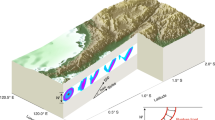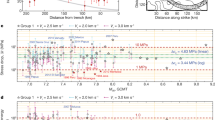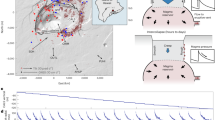Abstract
THE duration of rupture is a fundamental characteristic of earthquakes, and is important for understanding the mechanics of faulting1,2. The complexity of the seismic source and the incoherence of the high-frequency seismic wavefield often inhibit the identification, location and timing of features in the later part of earthquake rupture. Here we sum many teleseismic records from regional seismic arrays, producing an unusually clear depiction of the earthquake source at short periods by suppressing background noise and coda generated near the receivers. The ending, as well as the beginning, of rupture is clearly identifiable for most earthquakes examined. Measurements of 130 large earthquakes show that near 100 km depth, rupture duration averages 11 s when scaled to a moment of 1026 dyn cm; this decreases to 5.5 s at 650 km depth. Models of faulting suggest that duration should be inversely proportional to the shear-wave velocity and the cube root of stress drop. Thus, to explain the observed twofold decrease in duration with depth, stress drops would have to increase by a factor of four, as shear velocity increases with depth by only about 20%. However, observed stress drops show no strong trend with depth3,4, suggesting that the faulting process changes with depth.
This is a preview of subscription content, access via your institution
Access options
Subscribe to this journal
Receive 51 print issues and online access
$199.00 per year
only $3.90 per issue
Buy this article
- Purchase on Springer Link
- Instant access to full article PDF
Prices may be subject to local taxes which are calculated during checkout
Similar content being viewed by others
References
Kanamori, H. A. Rev. Earth planet. Sci. 14, 293–322 (1986).
Wald, D. J. thesis, California Inst. Technol., Pasadena (1992).
Houston, H. & Williams, Q. Nature 352, 520–522 (1991).
Frohlich, C. Rev. Earth planet. Sci. 17, 227–254 (1989).
Benz, H. M., Vidale, J. E. & Mori, J. EOS (submitted).
Kanamori, H. & Anderson, D. L. Bull. seism. Soc. Am. 65, 1059–1072 (1975).
Kanamori, H. & Given, J. W. Phys. Earth planet. Inter. 27, 8–31 (1981).
Ekström, G. thesis, Harvard Univ. (1987).
Ekström, G. & Engdahl, E. R. J. geophys. Res. 94, 15499–15520 (1989).
Kuge, K. J. geophys. Res. (in the press).
Glennon, M. A. & Chen, W.-P. J. geophys. Res. 98, 735–769 (1992).
Fukao, Y. & Kikuchi, M. Tectonophysics 144, 249–269 (1987).
Chung, W. & Kanamori, H. Phys. Earth planet. Inter. 23, 134–159 (1980).
Wiens, D. A. J. geophys. Res. 94, 2955–2972 (1989).
Mikumo, T. J. Phys. Earth 19, 303–320 (1971).
Houston, H. Geophys. Res. Lett. 17, 1021–1024 (1990).
Green, H. W. & Burnley, P. C. Nature 341, 733–737 (1989).
Kirby, S. H. J. geophys. Res. 92, 13789–13800 (1987).
Anderson, D. L. & Bass, J. D. Nature 320, 321–328 (1986).
Ito, E. & Takahashi, E. J. geophys. Res. 94, 10637–10646 (1989).
Vidale, J. E. & Benz, H. M. Nature 356, 678–683 (1992).
Dziewonski, A. M. & Woodhouse, J. H. J. geophys. Res. 88, 3247–3271 (1983).
Author information
Authors and Affiliations
Rights and permissions
About this article
Cite this article
Vidale, J., Houston, H. The depth dependence of earthquake duration and implications for rupture mechanisms. Nature 365, 45–47 (1993). https://doi.org/10.1038/365045a0
Received:
Accepted:
Issue Date:
DOI: https://doi.org/10.1038/365045a0
This article is cited by
-
Similar seismic moment release process for shallow and deep earthquakes
Nature Geoscience (2023)
-
A Review on Scaling of Earthquake Source Spectra
Surveys in Geophysics (2019)
-
Seismic Source Parameters of Normal-Faulting Inslab Earthquakes in Central Mexico
Pure and Applied Geophysics (2016)
-
Near-Field ETAS Constraints and Applications to Seismic Hazard Assessment
Pure and Applied Geophysics (2015)
-
Source time function properties indicate a strain drop independent of earthquake depth and magnitude
Nature Communications (2013)
Comments
By submitting a comment you agree to abide by our Terms and Community Guidelines. If you find something abusive or that does not comply with our terms or guidelines please flag it as inappropriate.



